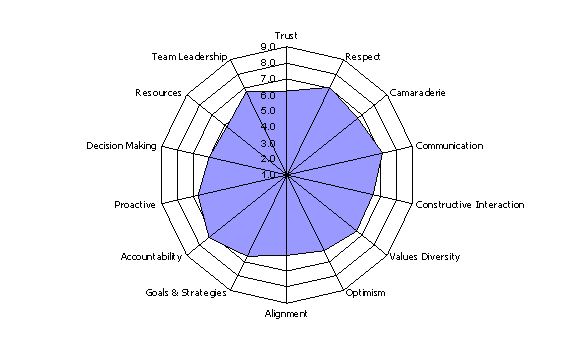|
|
 |
|
 |
TEAM COACHING
|
|||
|
Team Resource Coaching believes organizations are comprised of sets of nested teams, and that the organization, and each team within it, may be viewed as a system. |
| |
| home |
| team coaching |
| team diagnostic assesment |
| team process |
| executive coaching |
| about kathryn |
| contact |
![]()
| TEAM DIAGNOSTIC™ ASSESSMENT | |||||||||||||||||
Team Diagnostic™ Assessment Process The Assessment tool is customized to meet specific team requirements. It yields a powerful mapping process to identify next steps for team development with strong accountability for team members. The Assessment provides an accurate benchmark for teams and serves as a jumping-off point for important conversations. In the end, it is the team that will decide the course direction for the next phase of the journey. Team members will receive invitations via e-mail to complete the on-line Team Diagnostic™ Assessment. This tool is designed to effectively capture results while minimizing team members’ time. All responses are completely anonymous. The assessment has 80 questions. Three open-ended, customized questions will be added to probe specific, current issues affecting the team. (By way of example, a question might ask the team members to identify what they consider as the top three priorities for the organization.) The assessment takes approximately 15-20 minutes to complete on-line. The results are provided at a high macro level and then progressively drill down to very specific measures and issues for the team, i.e. top high and low factors for the team to be conscious of and to focus its development. The results of the assessment are used by the coach/facilitator to design the team development retreats. To download a sample Team Diagnostic™ Assessment report, click here The Team Diagnostic™ Model The following graphic illustrates some of the characteristics of teams according to where they fall in the four quadrants of High and Low Positivity and Productivity: |
|||||||||||||||||
|
|||||||||||||||||
The Team Diagnostic™ model defines 7 productivity factors and 7 positivity factors
Following is a sample “polar view” of the results for a team, with the blue area showing the levels of team strengths, and the white area representing opportunity for growth. The coach/facilitator works with the team to leverage their strengths to address areas of opportunity. In this example, the team coaching process would focus on having the team use its strengths – accountability, respect and communication – to create greater levels of alignment and trust and to make best use of resources. The full assessment report also provides a deeper cut into these areas, creating an opening for team coaching that will focus on the team’s greatest opportunities. Team Development Retreats provide team members with the conceptual framework and foundational competencies for understanding the dynamics of the team as a system. The workshops include working with the Team Diagnostic™ Assessment and Profile, and Team Skills training as necessary for on-going team development. The workshops are interactive and experiential; team members leave with new awareness, tools and skills they can apply right away. To download a sample Team Diagnostic™ Assessment report, click here |
| |

The team coaching model advocated at Team Resource Coaching was developed by Team Coaching International. Core to the TCI approach is a state-of-the-art Team Diagnostic™ Assessment that provides a systems-based benchmark and detailed map for on-going team development. Team Resource Coaching is proud to be one of 150 Authorized Facilitators world-wide who can deliver the Team Diagnostic™ Assessment.
|
